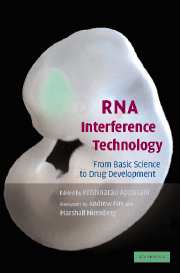Book contents
- Frontmatter
- Contents
- Foreword by Andrew Fire
- Foreword by Marshall Nirenberg
- List of Contributors
- Introduction
- Section one Basic RNAi, siRNA, microRNAs and gene-silencing mechanisms
- Section two Design, synthesis of siRNAs
- Section three Vector development and in vivo, in vitro and in ovo delivery methods
- Section four Gene silencing in model organisms
- Section five Drug target validation
- Section six Therapeutic and drug development
- 26 RNAi-mediated silencing of viral gene expression and replication
- 27 RNAi in drug development: Practical considerations
- 28 RNA interference studies in liver failure
- 29 RNAi applications in living animal systems
- Section seven High-throughput genome-wide RNAi analysis
- Index
- Plate section
- References
28 - RNA interference studies in liver failure
Published online by Cambridge University Press: 31 July 2009
- Frontmatter
- Contents
- Foreword by Andrew Fire
- Foreword by Marshall Nirenberg
- List of Contributors
- Introduction
- Section one Basic RNAi, siRNA, microRNAs and gene-silencing mechanisms
- Section two Design, synthesis of siRNAs
- Section three Vector development and in vivo, in vitro and in ovo delivery methods
- Section four Gene silencing in model organisms
- Section five Drug target validation
- Section six Therapeutic and drug development
- 26 RNAi-mediated silencing of viral gene expression and replication
- 27 RNAi in drug development: Practical considerations
- 28 RNA interference studies in liver failure
- 29 RNAi applications in living animal systems
- Section seven High-throughput genome-wide RNAi analysis
- Index
- Plate section
- References
Summary
Clinical features and molecular mechanisms of acute liver failure
Both acute and chronic hepatic failure present diseases associated with high mortality. Acute liver failure (ALF) is a dramatic clinical syndrome in which a previously normal liver fails within days or weeks, resulting in haemorrhage, electrolyte and metabolic disturbance, cardiovascular instability, renal failure, cerebral oedema and encephalopathy. Worldwide the most frequent cause of acute liver failure is viral hepatitis. Advances in intensive care monitoring and the establishment of liver transplantation programmes have made a significant impact on survival of patients with ALF in the last 30 years. Depending on the time course three subgroups of ALF have been proposed: hyperacute, acute and subacute liver failure (O'Grady et al., 1993). Patients with hyperacute disease have the most favorable prognosis, while survival of patients with acute and subacute liver failure is still less than 15% (Plevris et al., 1998). Currently for the majority of the patients with acute and subacute liver failure orthotopic liver transplantation is the only curative therapy with long-term survival rates of approximately 90%. Organ availability, however, remains the most important limiting factor for liver transplantation. Although some patients may recover without liver transplantation, most of the patients die while waiting for a donor liver. Attempts have been made to remove toxins and to provide important liver products by the use of bioartificial supports systems. The objectives of these bioarteficial support system is to bridge patients to transplantation or recovery.
- Type
- Chapter
- Information
- RNA Interference TechnologyFrom Basic Science to Drug Development, pp. 396 - 405Publisher: Cambridge University PressPrint publication year: 2005



